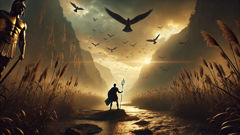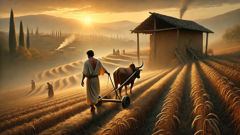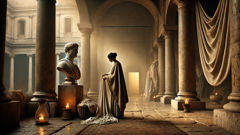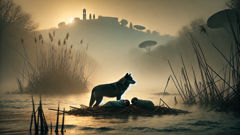Introduction
Lake Stymphalus lay like a wound in the thigh of Arcadia: a shallow basin of black water, reeds, and the whispers of men who measured their days by the tolling of the bell at the temple. In the mornings the surface held the dull gleam of silt and the mirrored silhouettes of hawthorn and cypress; by night it breathed a different breath, cooling the rock and drawing fog from the pool in a slow, sighing swirl. For years the shoreline had been a place of tallying loss. Farmers brought bones found at the water's edge to the magistrates, wives woke to the silence of children who had gone to fetch eggs and never returned, and travelers kept their hands on their blades while passing the reeds. They called the predators birds, but these were not mere cranes or eagles. Villagers who glimpsed them described bronze beaks that clanged against polished stone, feathers like hammered metal that caught and flashed the sun into angry knives, and eyes the color of wet iron that seemed to calculate hunger by the curve of a throat. Stories proliferated in the taverns: the birds came from a curse, from the broken promise of a river god, from a blacksmith's oven that had cooled wrong, from Athena's wrath turned inward. Myth braided with fact until the line between the two had thinned. When Heracles arrived at the lip of Stymphalus—broad-shouldered, still smelling of the dust of earlier labors—he found a landscape strained tight with fear. The people spoke in fragments: the birds nested in the reeds and in the trees above the marsh; they ate men and cattle and the first of the harvest; their metal feathers could be thrown and would ricochet to kill; their squawks betrayed both challenge and hunger. At night the flock filled the sky, a tessellated motion of glittering blades that turned moonlight into a rain of sparks. Heracles listened, his coat damp with sweat, the simple logic of the son of Zeus unfolding in him. This labor would not be brute strength alone. Even a man with the arms to hurl boulders could not uproot birds that nested beyond reach and fell like a storm upon the plain. He would need wit, a gift for contrivance, and perhaps the small mercy of the gods. So he sought counsel at the temple, where offerings steamed and the scent of laurel and smoke braided in the air. There, among votive statuettes and trembling votaries, a child spoke of clappers—krotala—handed down by an old priest who once heard Athena whisper in his dreams. It was said the goddess of wisdom had once given such instruments to frighten beasts from the fields, to scatter the nests of venomous creatures, and to herald the arrival of heroic deeds. The old priest, hearing the son's name, told the story with a voice that only just kept trembling: Athena would not remove the burden from man, but she might grant him a means to open the right door. Under a waning sky, with the reeds hissing like the rustle of armor, Heracles set himself the task of learning how to make a sound impossible to ignore and impossible to resist. He understood then that the Stymphalian Birds were less a natural hazard and more a sign that the world around mortal men had been nicked by a god's temper. To restore balance, he would have to be both instrument and interpreter of the gods' will.
The Marsh, the People, and the Metal-Flecked Sky
The first time the villagers of Arcadia had seen the birds in full array, they thought the sky itself was unraveling. At noon a cloudless blue was split by the glint of wings that sounded like rafts of bronze colliding, and by dusk the shore was littered with feathers that clinked when the children gathered them in kerchiefs. Some feathers were soft at the base and sharp at the edge, as though the bird had been welded from two crafts: the living sinew and the forger's art. They could be caught in flesh, and when a farmer tried to pluck one from a hind leg, the feather did not bend but held, cutting like a new razor. The elders had names for many things—names carry the authority of survival—and they called the flock the Stymphalian Birds after the lake that hid them. The name carried the geography of danger. The reeds of Stymphalus grew tall enough to hide a man; under the water, roots and silt made secret mazes. The birds nested in the hollows of oaks and the thick branches of ash, where their metallic plumage chimed low in the wind like a choir of small anvils. Their beaks were of bronze, younger than the earth and colder than a tomb. They could peck a door as though it were paper and could wrench off the hinge of a gate; they could carry off children if the pattern of the day allowed. At first the magistrate sent hunters with spears and with nets, but nets tore and spears bent or simply glanced off the iron-fused breast of the birds. Some hunters returned with arms braided around their ribs and a silence in their eyes that the villagers came to dread. In a place where myth and memory were already braided, one tragedy became a parable of many. The birds were not merely predators. People said they had learned to use metal as a second skin, to sharpen their feathers into projectiles, to ricochet the sun into flashes that would blind for a moment and disorient for a lifetime. Stories told of a shepherd whose dog was taken mid-bark, of a woman whose apron was ripped free and who survived only because she tripped at the edge of the marsh and the birds flew overhead, missing the smaller prize. The village council, which met under the open sky when no safe place remained for indoor councils, argued as councils do: whether to flee and seek clemency in a neighboring polis, whether to try to drown the flock by burning the reeds around the lake, whether to appeal to the gods directly with sacrifice and supplication. But the birds were not wholly of the earth, and the smoke bent from them as if a wind took pity and carried the burning reed scent away. If you approach this tale wanting only a catalogue of violent set pieces, you will miss the texture of what made the birds a plague: they transformed ordinary rhythms. The bread taken to the baker in the morning might be snatched from a hand in a heartbeat; festivals that once rang with lyres were shortened because no family could afford to look long at the light. Parents began to guard the steps of their houses with iron and with prayers. In that anxious hour, two things happened that would change the fate of the lake. First, Heracles arrived—the son of Zeus, who already bore the rubbed skin and the stories of other labors pressed like bookmarks between his hands. People watched him from windows, weighing hope against the knowledge that most help comes with a cost. Second, a priestess in the temple of Athena remembered the old instruments hidden behind the temple drapes: krotala, clapping devices of bronze fashioned for ritual and for the dispersal of certain pests. Athena, the story said, would not give him strength to cut the birds to pieces with brute force; she would give him a sound that forced the birds out into a pattern he could master. Whether the priestess truly heard the goddess or only heard the memory of a dream mattered less than that a plan formed. They fashioned the krotala from bronze and bone, and the metal clicked like a thousand small hearts. Heracles took them and tested their note until it cut through his own blood's cadence. He walked the marshes at dawn with the clappers wrapped in leather, feeling the reed sludge sift between his toes, imagining the flock's wingbeats. He did not yet know how the birds would respond, only that a single human voice, given a new instrument, could be the pivot around which a flood turns. While it is easy to place the emphasis on gods and on the hero's right arm, there is in the antecedent days an ecology to consider. The birds flourished because something in the marsh had been changed—some feeding ground grown acid with refuse, some predator driven off by men who feared their own shadows. In many myths the monster is a symptom. The Stymphalian Birds were an answer to balance gone askew, a solution the world had offered in the absence of a more regular predator. Men took an ax to their own woods, ejected one species, and another came forward to fill the niche, bent by bronze and hunger into a thing of legend. That reality—so earthy and practical—made the need for a mythic response reasonable. If a god had tilted the world, a god might again nudge it upright. If men had wounded the balance, perhaps a hero might knit it back together with practical cunning and the small mercy of ritual noise. Heracles' plan, then, grew from a mosaic of details: the clanging of bronze, the birds' hatred of certain sounds, the open planes where he might trap them. But plans must meet reality in the reeds, and reality seldom arrives modestly. On the third day after the krotala were finished, Heracles climbed a hill where the reed met a faint copse and waited. The flock blackened the sky at noon, and the sound of their wings was like armor dragged across stone. When they descended, their beaks clicked like teeth on metal. Heracles released the clappers and beat them until the sound rode over the lake like a small thunder. The birds shivered. Some wheeled away; others peered from branches as if estranged. Then, with a wild and furious intelligence, the entire flock rose to meet the sound, and for a moment the sky became a single moving blade. Heracles let the noise run and then released his arrows. Each arrow flew true, tipped with the knowledge that a hero must sometimes convert a tool of patronage into a weapon of necessity. The birds fell, their metallic feathers scattering like coins across the marsh. The villagers came forward, cautious, to gather the dead, and in that act there was both danger and a new rite: to bury a thing that had been partly made by metal and partly by hunger. Their burial was awkward, bending the old rites around new instruments. They could not burn such feathers; the metal did not yield to flame the way the villagers wanted. So they stored them in shrines and sealed them with prayers and offerings to Artemis and to the river gods, asking the living world to hold, for once, what had been wrought by human hands and divine temper combined.

The Cunning of Heracles and the Turning of the Sky
Heracles had arrived in Arcadia already marked by stories: the lion's skin across his back, the memory of Nemea's unyielding pelt, and the weight of the earlier tasks like a braided rope at his belt. But the Stymphalian labor demanded something else—a geometry of sound and space. He stood on ground that became slick underfoot, where cattails began to finger the water and the air smelled always of iron and damp stone. The krotala that Athena's priestess had lent him were small, unassuming things: clappers of bronze on thongs, inlaid with bone and tied with leather cords. When Heracles first clicked them together, the sound was less dramatic than the stories promised, a sharp, rhythmic clack that cut the hush. Yet rhythm, once adopted, becomes command. Heracles walked the path the villagers had marked as the birds' favorite corridor; he measured the tree-line and the reed line with his eyes like a mason eyeing a wall. He arranged himself on a promontory, and the villagers watched from the safety of the far bank, their shadows long and expectant. The first hour of the tactic was a test. Heracles walked the edge of the reeds, clacking the krotala, and the birds kept to the branches. Then he changed the tempo. Slow, then staccato, then a panic pattern that mimicked distress. The flock's answer was immediate: they rose and came in a dark, glittering deluge. The sound had prodded an instinct older than bronze; the birds gathered like a single body to challenge the new noise because they could not abide a sound that seemed to break the air. It was then that Heracles did what only a man both brave and measured could do: he did not simply bring the birds down by slaughter. He manipulated them. He used the krotala to steer the flock into a thin valley between two low ridges where the reeds were shorter and the water deeper. A true trap does not need walls when it has space angled to the hunter's advantage. As the flock funneled in, Heracles loosed shafts tipped with iron and flame. His arrows found the birds' throats and wings, but each strike also showed him how cunning the creatures were. They adapted, circling higher, raining feathers like shrapnel. One feather, thrown by a bird in a desperate twist, struck a rock and ricocheted into the thigh of a man attending from the bank, and the crowd recoiled as if the marsh itself had turned treacherous. The hero's heart is often imagined as a simple thing—full of courage, empty of calculation—but here courage meets calculation. Heracles' method combined the god-breathed gift with the blunt mechanics of nature: find the pattern, then bend it. He kept changing the beat of the krotala until the birds' flight created an opening. Then, with a single great push, he shifted tempo and direction. The flock, lacking the nimble will of a man and responding only to pattern and instinct, funneled where he intended. The slaughter that followed was terrible to watch. The birds tumbled, their bronze beaks striking the water and the reeds, their feathers clacking against one another like a chorus of miniature anvils. Men and women of the village moved like a hive to gather the fallen and to drag them toward the silt where they might be buried or displayed as trophies and warnings. Heracles himself felt the moral tinge to the act; he had not wanted simply to exterminate life, but to restore safety. The sacrifice of many monsters, in myth, is often the necessary currency for the return of order. Yet the story that grew afterward concerned more than mere slaughter. There was a singular moment when Heracles, exhausted and sodden with marsh water, found himself facing a lone bird unlike the others. It was larger, older, its feathers not only metallic but patterned with the green of tarnished bronze. Its eye was the dull color of an old coin, and for a heartbeat the two looked at one another and somehow recognized the strange kinship of creature and man who share the planet's skin. The bird did not flee. Instead it tilted its head and made a sound beneath its beak that was not a cry but a note almost like a question. In that pause Heracles did not raise his bow. He lowered it. He could have loosed an arrow that would have ended the bird's life and perhaps the threat as a whole more quickly. Yet he had the sense, faint but sure, that some balances were not for the hammer of a hero alone to correct. The elder bird's survival, and the sparing of a few chosen others, would allow the marsh to remember its place in the world: predator and prey, season and recovery. So Heracles spared the elder. He sent the bird wheeling into a higher sky where it would become less a menace and more a memory: a caution for men about the shape of their own choices. When the dust and the feathers settled, the villagers came forward with songs that were half praise and half raw relief. They raised the krotala in the temple to Athena and set a sheaf of bronze feathers—kept in the shrine out of both dread and respect—beneath the goddess's statue. The priestess who had recalled the instruments was given a small piece of land to tend and a title that ensured the story she had told would be heard by children. And Heracles, whose name would be amplified by the memory of the labor, took from the event a lesson in economy. Strength matters, but so does cunning allied with restraint. He had known before he came what brute force could achieve and what it could destroy. He had balanced the two. Yet tales do not end with the last arrow. There are afters to every great deed: how the land mends and how people learn that the line between exploitation and stewardship is fine. In the seasons after the battle, the reeds of Stymphalus began to reassert themselves. The water cleared in places where silt had been churned, and new reeds rose like a second growth. Villagers introduced measures that might seem, to modern ears, a small science: watchposts, a rotation of fields so that the birds could not become habituated to a single food source, and restrictions on cutting the shoreline trees so that the birds would be fewer tempted into close nesting. Children were taught the old songs that warned of the birds' approach, and new songs came into being—songs that told of the day a man used a goddess's clappers to turn the sky into an instrument. That human practice of living with nature rather than trying to annihilate its difficulties was not only practical but became a kind of ritual civility. The memory of the Stymphalian Birds thus became bilingual: it was both a story of terror and a manual on how a village could reweave the social fabric that had been frayed by fear. Heroes, in the end, make room for communities to decide how they will live once the immediate threat is dealt with. The hero leaves; the people remain and must learn the rhythms of continued life.

Conclusion
The legend of the Stymphalian Birds endures because it speaks to a practical tenderness that lies at the heart of many ancient tales: the recognition that monsters are often the blurred outlines of something broken in the world, and that the cure requires not only strength but imagination. Heracles' labor at the lake did not simply remove a threat; it forced a reckoning between villagers and their surroundings, and it held up a mirror to how humans make and unmake the environment around them. The birds, with their bronze beaks and metallic feathers, were terrifying devices of myth and of truth—proof that any shape can be given to hunger when men forget the long cycles of care. The krotala, the clapping bronze Athena provided, was a small instrument with an outsized power: the power to change pattern. That moral—of pattern and of change—lingers in the way children still find old feathers in straw baskets, in how elders still talk about rotating grazing and watching the reed line, and in the manner by which songs about the labor turn up at weddings and wakes, at times when customs must remind communities of their limits. The story offers both spectacle and instruction. It reminds us that courage is not merely the breaking of a foe but the fashioning of an arrangement where both human life and the wild can endure. The Stymphalian Birds remain in the sky of our imagination as a warning and a challenge: to face what is monstrous with wit, to listen for the gifts that gods—or good ideas—may hand us, and to temper victory with the knowledge that the world heals where care replaces fury. In that sense the labor at Stymphalus was less an end than a beginning, an ancient blueprint for how people can restore balance when they have unbalanced it, and a testament to the idea that myth persists because it teaches us, in story-form, to live better in the world we did not make and must, nonetheless, protect.













